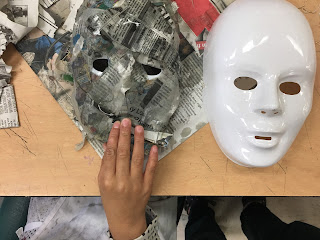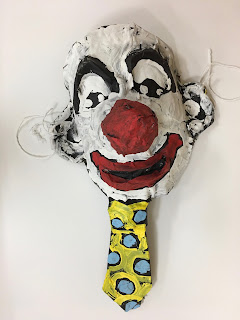 Mask making projects cover many important art standards. Through last week's lesson, we touched on the relationship between form and function, with a slide discussion on the purposes of masks (surgeonis mask, ski mask, catcher's mask, masquerade mask etc.).
Mask making projects cover many important art standards. Through last week's lesson, we touched on the relationship between form and function, with a slide discussion on the purposes of masks (surgeonis mask, ski mask, catcher's mask, masquerade mask etc.). Then my students learned about various cultures as I let them handle masks from Africa, Tonga, Fiji, and Chile and discuss the purposes, characteristics and medium for each.

They learn about contemporary art. I met wonderful artist, Jill
Foote-Hutton at her solo show at Wesleyan College. She was generous
enough to leave some of the masks from the interactive part of her
monster exhibition for me to share with my students. (Shown here). As a
class, we discussed her aesthetics and paper mache technique.
My students also relearned to generate ideas through sketching. This student is completely blind and so he used wiki-sticks to convey his ideas.
They learned to build an under-structure, making their sketches into a 3D reality, using old cereal boxes, discarded foam, cardboard, and plastic bottles taped together. This teaches creative problem solving AND environmental issues such as how to reduce waste and reuse clean trash.

They learned the sculptural technique of paper mache. This is done by tearing newspaper strips with the paper grain, and using liquid starch to dip the strips. My elementary school students used pre-made plastic masks as a mold. Some high school students tried using paper pulp (paper in the blender with water) and glue. If liquid starch is hard to find, a mixture of water and glue or even water and flour will work. About five layers of paper should be enough.
 Students learned to paint a 3D object. Most of them used black acrylic or latex underpainting like Jill Foote-Hutton, which sealed, strengthened, and smoothed the surface. Then they added the color layer, leaving some areas intentionally black. Wiki sticks or tape helped create a barrier for my blind students to know where to paint.
Students learned to paint a 3D object. Most of them used black acrylic or latex underpainting like Jill Foote-Hutton, which sealed, strengthened, and smoothed the surface. Then they added the color layer, leaving some areas intentionally black. Wiki sticks or tape helped create a barrier for my blind students to know where to paint.


A few of them learned about performance and how to scare other teachers in my hall. So between the interdisciplinary take or the aesthetic take, or the skills and techniques take on this lesson, there's no question that a lot is being learned.
I had two high school boys tell me day one, "This is going to be my favorite project this year!" By the third day, they were going to take zeros because things just weren't working out. But in the end, it was, in fact, their favorite project, which tells me they are learning one of art's most important lessons- perseverance pays.


























